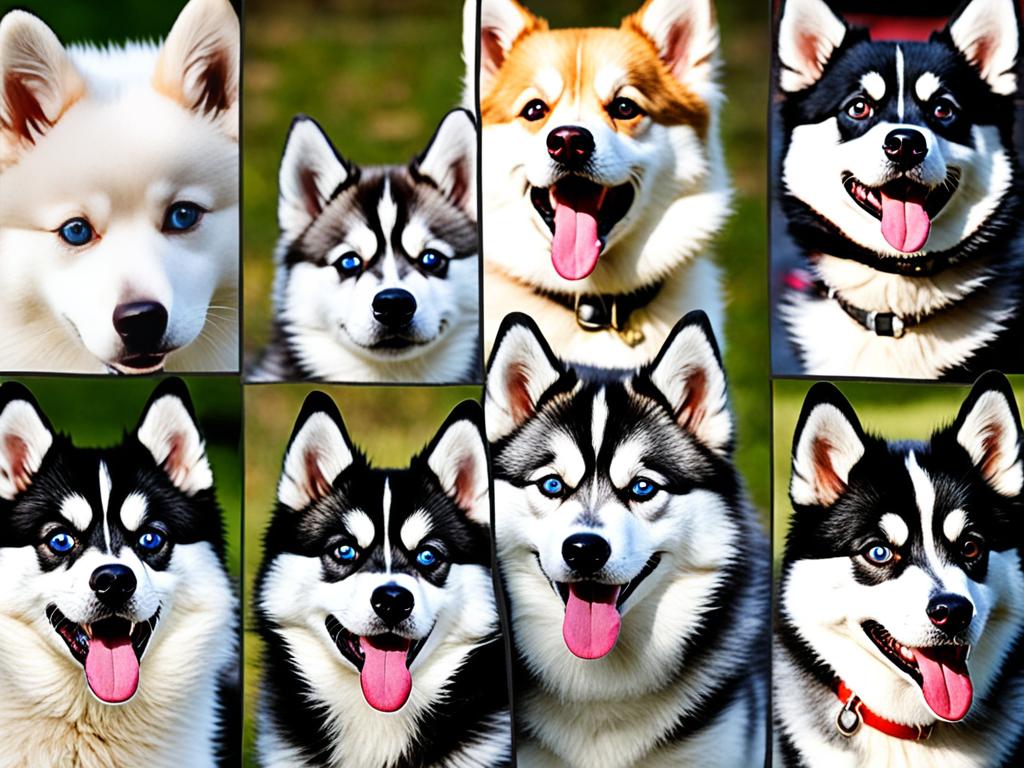Did you know that Pomskies, the adorable hybrid breed of Pomeranian and Siberian Husky, have their own unique way of communicating with their owners and other dogs?
In this article, we will explore the nuances of Pomsky vocalization and communication, helping you better understand and connect with your hybrid canine companion. From deciphering their barks to interpreting their body language, we will delve into the fascinating world of Pomsky communication.
Key Takeaways:
- Pomskies have a unique way of communicating with their owners and other dogs.
- Understanding their vocalizations and body language can strengthen your bond with your Pomsky.
- Training techniques and consistent communication are essential for effective Pomsky communication.
- Recognizing their behavioral cues can help address and prevent issues.
- Socialization plays a crucial role in developing a well-rounded and communicative Pomsky.
The Origins of the Pomsky Breed
The Pomsky breed originated in the United States in the early 2000s. This hybrid breed was created by intentionally crossing Pomeranians with Siberian Huskies, with the aim of producing a smaller version of the Husky that would be well-suited for apartment living. The breeders wanted to retain some of the physical characteristics and personality traits of both parent breeds in the resulting Pomskies.
As a result of this intentional crossbreeding, Pomskies have a unique temperament and communication style that combines elements of both the Pomeranian and the Siberian Husky. While they are smaller in size than Huskies, they still possess the energy and playfulness of their larger relatives. Their communication style is a blend of the more vocal nature of Pomeranians and the distinctive body language of Huskies.
Understanding the origins of the Pomsky breed provides valuable insights into their temperament and communication patterns. By recognizing the influences of their parent breeds, owners can better interpret and respond to their Pomsky’s behaviors, needs, and desires.
To visually showcase the origins of the Pomsky breed, here is an image of a beautiful Pomsky:
Personality Traits of Pomskies
Pomskies are known for their playful and energetic nature. They have inherited the active temperament of the Siberian Husky and the spunky personality of the Pomeranian. This unique combination makes them a delightful companion for active individuals or families.
These hybrid dogs love to play and engage in various activities that allow them to burn off excess energy. Whether it’s fetching a ball, going for a run, or participating in agility training, Pomskies thrive when they have opportunities to exercise both their bodies and minds.
While Pomskies may not talk like Huskies, they are often quite vocal in their own way. They have a tendency to bark or whine to communicate their needs or desires. Understanding their vocalizations and behavior is essential in deciphering their messages and ensuring effective communication.
To better connect with your Pomsky and meet their needs, it is crucial to analyze their vocalizations and behaviors. By doing so, you can develop a deeper understanding of their wants and emotions, allowing you to respond appropriately and create a harmonious bond.
Key Traits of Pomskies:
- Playful: Pomskies have a zest for life and love to engage in playful activities.
- Energetic: These hybrid dogs have plenty of energy to burn and require regular exercise.
- Vocal: Pomskies are known to be vocal, expressing their needs through barking and whining.
- Intelligent: They inherit the intelligence of both parent breeds, making them quick learners.
- Friendly: Pomskies are generally friendly towards both humans and other animals when properly socialized.
In summary, understanding the temperament and communication style of Pomskies, including their vocalizations and behaviors, is essential for effective communication. By embracing their playful nature, providing regular exercise, and interpreting their vocal cues, you can foster a strong bond and ensure a fulfilling relationship with your Pomsky.

Communication Cues of Pomskies
Pomskies are known for their unique ways of communication through a combination of body language, facial expressions, and vocalizations. Understanding these communication cues can help you effectively connect with your Pomsky and meet their needs.
One essential aspect to observe is their posture. A relaxed and upright posture generally indicates a calm and content Pomsky, while a lowered or crouched posture may suggest fear or submission. Additionally, tail movements can provide valuable insights. A wagging tail usually signifies a happy or excited Pomsky, while a tucked tail might indicate fear or anxiety.
Pay attention to their ear positions as well. Erect ears often indicate focus or attentiveness, while flattened ears might suggest fear or discomfort. Eye contact is another crucial cue. Direct eye contact can be a sign of trust, while avoiding eye contact may indicate fear or submission.
Furthermore, familiarizing yourself with the sounds they make can greatly enhance your understanding of their needs. Pomskies can use a variety of vocalizations such as barks, whines, and howls. For instance, a high-pitched bark may signal excitement or alertness, while a low growl can indicate aggression or unease.
By being observant of these communication cues, you can develop a deeper understanding of your Pomsky’s emotions and intentions. This understanding will enable you to respond appropriately and strengthen the bond between you and your furry companion.
Facial Expressions and their Meanings
Pomskies communicate a great deal through their facial expressions. Here are some common facial expressions and their meanings:
- Relaxed and open mouth: Indicates a calm and content Pomsky.
- Tense or closed mouth: Suggests anxiety or discomfort.
- Dilated pupils: Can indicate fear, excitement, or arousal.
- Showing teeth: Signifies aggression or a warning.
- Yawning: Can indicate stress or relaxation.
- Licking lips: May suggest anxiety or anticipation.
Learning to interpret these facial expressions in context with other communication cues will give you a comprehensive understanding of your Pomsky’s emotions and help you communicate effectively with them.
| Posture | Meaning |
|---|---|
| Relaxed and upright | Calm and content |
| Tucked or crouched | Fear or submission |
| Wagging | Happiness or excitement |
| Tucked | Fear or anxiety |
| Erect | Focus or attentiveness |
| Flattened | Fear or discomfort |
By understanding and interpreting these communication cues, you can establish a stronger connection with your Pomsky and effectively address their needs and emotions.
Training Techniques for Pomsky Vocalization
Training your Pomsky to effectively communicate is essential for building a strong bond and understanding. By utilizing positive reinforcement methods, such as reward-based training, you can teach your Pomsky to communicate on command or in response to specific cues. Consistency, patience, and clear communication on your part are key in helping your Pomsky learn and respond appropriately.
Tips for Communicating with Your Pomsky:
- Use positive reinforcement: Reward your Pomsky with treats, praise, and affection when they communicate successfully or respond to your cues.
- Be consistent: Use the same commands and cues consistently to avoid confusion and establish a clear communication routine.
- Keep training sessions short and frequent: Pomskies have short attention spans, so regular short training sessions will yield better results than long, infrequent ones.
- Be patient: Understanding and effectively communicating with your Pomsky takes time and patience. Celebrate small successes and be persistent in your training efforts.
- Use clear body language and voice cues: Your Pomsky pays attention not only to your words but also to your body language and tone of voice. Use consistent gestures and a clear, calm tone to reinforce your commands.

Implementing these tips will help you create a positive training environment and strengthen the communication between you and your Pomsky. Remember, training is an ongoing process, so continue reinforcing good communication behaviors and adapting your training techniques as needed.
Body Language of Pomskies
The body language of Pomskies can provide valuable insights into their mood and intentions. Understanding how to interpret their nonverbal cues can greatly enhance your communication with these hybrid dogs.
Posture: Pay attention to your Pomsky’s posture. When they are relaxed and comfortable, their body will be loose and slightly lowered, showing a more confident and content demeanor. On the other hand, if your Pomsky is standing tall, with a stiff body and raised hackles, it may indicate that they are feeling threatened or defensive.
Tail Wagging: The position and movement of your Pomsky’s tail can communicate a range of emotions. A wagging tail held up high and moving vigorously usually indicates excitement, happiness, or anticipation. Conversely, a tucked tail or a tail held low between the hind legs may signify fear, anxiety, or submission.
Ear Positions: Observing your Pomsky’s ears can offer clues about their emotional state. When their ears are relaxed and in a natural position, your dog is likely calm and comfortable. However, if the ears are flattened against the head, it may indicate fear, anxiety, or aggression.
Eye Contact: Eye contact plays a critical role in communication with Pomskies. Direct eye contact is usually a sign of confidence and attentiveness. However, prolonged and intense eye contact can sometimes be perceived as a challenge or aggression. It’s important to understand your Pomsky’s comfort level with eye contact and respect their boundaries.
Overall Body Movements: Pay attention to your Pomsky’s overall body movements. A relaxed and loose body signifies a sense of ease and comfort, while a tense and rigid body may indicate stress, fear, or aggression. In addition, subtle movements like lip licking, yawning, or growling can further communicate your Pomsky’s emotional state.
By understanding and interpreting your Pomsky’s body language, you can better respond to their needs and emotions. This will foster a stronger bond and more effective communication between you and your furry friend.
Importance of Understanding Pomsky Vocalization
Effective communication with your Pomsky is essential for building a strong bond and ensuring their well-being. One crucial aspect of communication is understanding their vocalization. By being aware of their vocal cues and body language, you can better interpret their needs, emotions, and intentions. This understanding allows you to respond appropriately and create a deeper connection with your Pomsky.
When it comes to vocalization, Pomskies have their own unique ways of expressing themselves. They may bark, whine, or howl to communicate various messages, such as excitement, fear, or the need for attention. By paying attention to the tone, frequency, and context of their vocalizations, you can gain valuable insights into what your Pomsky is trying to convey.
Additionally, understanding Pomsky vocalization helps you differentiate between different types of barks and vocalizations, which can indicate specific needs or emotions. For example, a high-pitched, repetitive bark may indicate playfulness, while a deep, continuous bark could signal alertness or territorial behavior. By recognizing these vocal cues, you can appropriately respond to your Pomsky and meet their needs.
It’s important to note that vocalization is not the only form of communication for Pomskies. They also rely on body language and facial expressions to convey their emotions and intentions. By observing their posture, tail movements, ear positions, and eye contact, you can gain a comprehensive understanding of what your Pomsky is trying to communicate.
Effective Communication Tips:
- Pay attention to your Pomsky’s vocal cues and body language
- Familiarize yourself with their different types of vocalizations
- Respond appropriately to their needs and emotions
- Use positive reinforcement to encourage desired behavior
- Establish clear and consistent communication routines
By understanding Pomsky vocalization and effectively communicating with your furry companion, you can strengthen your bond, address their needs, and ensure a harmonious relationship. Take the time to learn and interpret their unique language, and you’ll reap the rewards of a deeper connection with your beloved Pomsky.

Creating a Communication Routine with Your Pomsky
Establishing a strong communication routine with your Pomsky is essential for building a deep bond and promoting effective communication. By consistently using clear words, gestures, and cues, you can help your Pomsky understand what you expect from them and what behavior is desired. Additionally, regular training sessions and positive reinforcement can further strengthen your communication bond and ensure a harmonious relationship with your Pomsky.
Here are some tips for creating an effective communication routine with your Pomsky:
- Use consistent verbal cues: Teach your Pomsky key words or phrases for common commands like sit, stay, and come. Use the same cues each time to help them understand and respond accordingly.
- Utilize non-verbal cues: Along with verbal cues, incorporate consistent hand signals or gestures for commands. This can help reinforce the verbal cues and provide additional clarity for your Pomsky.
- Establish a routine: Set a designated time each day for training and communication sessions with your Pomsky. Consistency and repetition are key to reinforcing desired behaviors and improving communication.
- Practice active listening: Pay attention to your Pomsky’s vocalizations, body language, and responses during training and interactions. This will help you better understand their needs and adjust your communication accordingly.
- Provide positive reinforcement: Reward your Pomsky with treats, praise, and affection when they respond correctly to your cues or demonstrate desired behavior. This positive reinforcement encourages them to continue communicating effectively.
Remember, effective communication is a two-way street. It’s important to be patient, consistent, and understanding with your Pomsky as you both navigate this communication journey together. By establishing a strong communication routine, you can enhance your bond with your Pomsky and ensure a happy, well-behaved companion.

Addressing Behavioral Issues through Communication
Effective communication with your Pomsky is crucial not only for building a strong bond but also for addressing any behavioral issues they may exhibit. By understanding their vocalizations and body language, you can identify potential triggers for problem behaviors and take proactive measures to address them. Consistent communication and positive reinforcement can help redirect negative behaviors and foster positive ones, creating a well-behaved and well-adjusted Pomsky.
Analyzing Pomsky Vocalization and Behavior
To effectively address behavioral issues, it is important to analyze Pomsky vocalization and behavior patterns. Pay attention to their different types of vocalizations, such as barks, growls, or whines, as each may indicate specific needs or emotions. Additionally, observe their body language, including posture, tail wagging, and ear positions, to gain further insights into their state of mind. By interpreting their vocalizations and behavior, you can identify potential triggers and effectively communicate with your Pomsky to mitigate these issues.
Proactive Communication Strategies
Once you have identified the triggers for certain behaviors, implement proactive communication strategies to address them. This includes setting clear boundaries and providing consistent reinforcement of acceptable behavior. Through positive reinforcement, such as rewards and praise, you can encourage your Pomsky to exhibit desirable behaviors while redirecting or discouraging negative ones.
Establishing Consistency and Routine
Consistency is key when addressing behavioral issues through communication. Establishing a routine that includes regular training sessions and daily interactions helps reinforce your expectations and allows your Pomsky to understand the rules and boundaries you have set. By maintaining consistency in your communication and reinforcing positive behaviors consistently, your Pomsky will develop a better understanding of your expectations and exhibit improved behavior over time.
| Behavioral Issue | Potential Triggers | Communication Approach |
|---|---|---|
| Barking excessively | Loneliness, boredom, fear | Provide mental stimulation, engage in interactive play, offer comforting cues |
| Jumping on people | Excitement, lack of boundaries | Teach and reinforce alternative greetings, remove attention when jumping occurs |
| Destructive chewing | Boredom, teething, anxiety | Provide appropriate chew toys and engage in stimulating activities, address underlying anxiety if present |
| Aggression towards other dogs | Fear, resource guarding, lack of socialization | Gradually expose your Pomsky to controlled interactions, use positive reinforcement to reward calm and appropriate behavior |
By understanding their vocalizations, analyzing behavior patterns, establishing consistency, and providing appropriate reinforcement, you can effectively address behavioral issues through communication with your Pomsky. Remember, patience, understanding, and positive reinforcement are key in building a strong and harmonious relationship with your furry companion.
Socializing Your Pomsky for Better Communication
Effective communication with your Pomsky is essential for a harmonious relationship and a well-adjusted canine companion. One crucial aspect of fostering effective communication is through socialization. By exposing your Pomsky to various people, animals, and environments from a young age, you can help them develop confidence, reduce anxiety, and improve their ability to communicate effectively.
Socialization plays a fundamental role in shaping the temperament and communication skills of your Pomsky. Positive experiences during socialization lay the foundation for a well-rounded and outgoing Pomsky that can confidently communicate in various situations.
The Benefits of Socializing Your Pomsky
When you socialize your Pomsky, you expose them to different scenarios that promote their overall wellbeing and enhance their ability to communicate effectively. Here are some benefits of socializing your Pomsky:
- Confidence: Socializing helps your Pomsky develop confidence as they become familiar with new experiences, people, and animals. Confident Pomskies are more likely to communicate their needs and desires effectively.
- Reduces Anxiety: By introducing your Pomsky to various environments and situations, you help them become accustomed to different stimuli, reducing anxiety and promoting calmness. This allows for clearer and more effective communication.
- Improved Communication: Socializing your Pomsky exposes them to a wide range of communication styles from other dogs and humans. This exposure helps them learn and understand different communication cues, improving their own ability to communicate effectively.
Overall, socializing your Pomsky helps create a well-adjusted and confident companion who can effectively communicate their needs and desires.
Tips for Socializing Your Pomsky
When socializing your Pomsky, it is essential to provide positive experiences and ensure their safety. Here are some tips to help you socialize your Pomsky:
- Start Early: Begin socializing your Pomsky as early as possible, ideally during their puppyhood. This period is crucial for their development and learning.
- Introduce Gradually: Introduce your Pomsky to new people, animals, and environments gradually. Start with familiar people and animals, then progress to new acquaintances over time.
- Positive Reinforcement: Use positive reinforcement techniques, such as treats and praise, to reward your Pomsky for calm and confident behavior during socialization.
- Observe Body Language: Pay attention to your Pomsky’s body language during socialization. If they display signs of fear or anxiety, take a step back and provide reassurance.
- Expose to Various Environments: Take your Pomsky to different environments, such as parks, cafes, and busy streets, to expose them to various situations and stimuli.
By following these tips, you can help your Pomsky become a confident and communicative companion.
Remember that each Pomsky is unique, and their socialization needs may vary. Be patient, provide positive experiences, and consult with a professional if you encounter any challenges during the socialization process.
Building Trust and Strengthening Communication with Your Pomsky
Building trust is a crucial aspect of effectively communicating with your Pomsky. By consistently meeting their needs, providing positive experiences, and using clear and consistent communication, you can establish a strong bond based on trust and understanding. This trust forms the foundation for open and effective communication, enabling you to address any concerns, train effectively, and create a harmonious relationship with your Pomsky.
Tips for Effective Communication with Your Pomsky:
- Be consistent: Consistency is key when it comes to communicating with your Pomsky. Use consistent verbal cues, gestures, and commands to ensure they understand your expectations.
- Provide positive experiences: By creating positive associations with communication and training, you can foster a sense of trust and engagement with your Pomsky. Use rewards, praise, and treats to reinforce desired behaviors and encourage effective communication.
- Listen and observe: Pay attention to your Pomsky’s body language, vocalizations, and behaviors. This will help you better understand their needs, emotions, and intentions, allowing for more effective communication.
- Use positive reinforcement: Reward your Pomsky for good behavior and effective communication. Positive reinforcement encourages them to repeat desired actions and strengthens the bond between you.
- Be patient: Effective communication takes time and patience. Give your Pomsky the opportunity to learn and understand your cues, and be patient with their progress.
By following these tips and consistently working to build trust through effective communication, you can establish a strong and meaningful connection with your Pomsky. Remember to prioritize their well-being and always communicate with kindness and understanding.
Conclusion
In conclusion, Pomskies have their own unique ways of communicating with their owners. Understanding their vocalizations, body language, and overall temperament is crucial for effective communication and building a strong bond with these hybrid dogs. By paying close attention to their cues and being responsive to their needs, you can better understand and connect with your furry companion.
Training also plays a vital role in enhancing the communication between you and your Pomsky. Positive reinforcement techniques, such as reward-based training, can help them learn to communicate on command and respond appropriately to specific cues. Consistency, patience, and clear communication are key in helping them understand your expectations and improving their overall behavior.
By consistently engaging in positive communication and nurturing a trusting relationship, you can ensure the well-being of your Pomsky. Their unique vocalizations and communication style, combined with your understanding and guidance, will result in a harmonious bond that brings you closer together.
FAQ
How do Pomskies communicate?
Pomskies communicate through a variety of cues, including body language, facial expressions, and vocalizations.
What are the different vocalizations of Pomskies?
Pomskies can make sounds such as barks, whines, and howls to express their needs and desires.
How can I understand my Pomsky’s body language?
Pay attention to their posture, tail movements, ear positions, and eye contact to interpret their emotions and intentions.
How can I train my Pomsky to communicate effectively?
Positive reinforcement methods, such as reward-based training, can be highly effective in teaching your Pomsky to communicate on command or in response to specific cues.
What is the importance of understanding Pomsky vocalization?
Understanding Pomsky vocalization is crucial for effective communication, as it allows you to interpret their needs, emotions, and intentions.
How can I establish a communication routine with my Pomsky?
Consistency in your words, gestures, and cues, along with regular training sessions and positive reinforcement, can help establish a strong communication bond with your Pomsky.
Can effective communication help address behavioral issues in Pomskies?
Yes, by understanding their vocalizations and body language, you can identify triggers for problem behaviors and take proactive measures to address them.
How does socialization impact Pomsky communication?
Socialization helps Pomskies develop confidence and improve their ability to communicate effectively by exposing them to different people, animals, and environments.
How can I build trust and strengthen communication with my Pomsky?
By consistently meeting their needs, providing positive experiences, and using clear, consistent communication, you can establish trust and create a strong communication bond with your Pomsky.

Leave a Reply